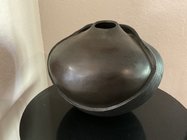As part of my Master's Degree (sculpture) I also worked as a GA with Roy Seiber who was (1972) the foremost authority on African Art (Indiana Univ.). Seiber noted the similar attitude referenced by the OP's phd's and countered it as being an excuse for "art-ignorant" (his term) people to stay that way. He illustrated his argument as follows:
Go to any tribal village in Africa that carries on masking ceremonies and solicit opinions by villagers about a particular mask. The men would likely inform you that the purpose of the mask was to "scare the children (to behave) and keep the women in their place." Others in the group, including the kids, would freely offer opinions about the quality of the mask as well as its likelihood to be effective in a ceremony Across all the age groups he would get considered and often detailed opinions and comments about the piece.
Seiber then suggested you go to New York's MOMA, borrow a semi-famous painting, set it up on an easel on the sidewalk, and solicit comments from people passing by. He maintained that most of what you'd get would be "I don't know anything about art, but I know what I like". Sieber would add to that as amounting to "and I like what I know."
His point was that the African society's art was a living, breathing part of the society that created it whereas art (however you wish to define it) in modern western societies has become disconnected from the culture that creates it, at best replaced with the intellectual pronouncements by allegedly knowledgeable pedants more than willing to spoon feed others as to "what's good" or "valuable."
The pedantics conveniently ignore that practically everything in our lives, from a toaster, to a car, to the computer screen you're reading this on has, to one extent or another, had some input by an artist. You might wish to call them a "designer" as if that justifies some devaluation of what they do, but artists they remain.


